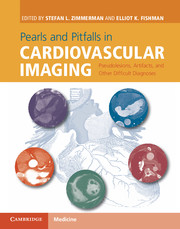 Pearls and Pitfalls in Cardiovascular Imaging
Pearls and Pitfalls in Cardiovascular Imaging from Section 2 - Cardiac aneurysms and diverticula
Published online by Cambridge University Press: 05 June 2015
Imaging description
Left atrial diverticula are outpouchings of the left atrial wall that communicate with the left atrial lumen. They are usually less than 1 cm in size (Figure 16.1), although rarely large diverticula may be encountered (Figure 16.2). Left atrial diverticula are usually lobulated in contour and may contain internal trabeculations (Figure 16.3). Some authors have made a distinction between left atrial diverticula, which are internally smooth, and accessory left atrial appendages, which have internal trabculations similar to the left atrial appendage. However, the distinction can sometimes be difficult given the small size of these structures. The most common location for left atrial diverticula is the right anterior–superior wall of the left atrium.
Importance
Left atrial diverticula can be important in patients who undergo atrial ablation procedures. Left atrial diverticula may be a source for ectopic arrhythmogenic foci, and can also be a cause for post-procedural thrombus formation. There is also a potential risk for perforation if diverticula occur adjacent to ablation lines or if catheters are inadvertently lodged within the diverticulum, given the relative thinness of the diverticular wall compared to the normal left atrial wall.
Typical clinical scenario
Left atrial diverticula are common, identified in 36% of atrial fibrillation patients undergoing pre-ablation cardiac CT. No differences have been found in the prevalence of diverticula among patients with atrial fibrillation and healthy controls.
Differential diagnosis
Left atrial diverticula should be distinguished from false aneurysms of the left atrial wall which could occur in the setting of prior trauma or surgery.
Teaching point
Left atrial diverticula are small outpouchings from the left atrial wall which are generally of no clinical importance. However, in patients who undergo ablation procedures they may be a source for arrhythmia or may carry a risk of perforation or thrombus formation.
To save this book to your Kindle, first ensure [email protected] is added to your Approved Personal Document E-mail List under your Personal Document Settings on the Manage Your Content and Devices page of your Amazon account. Then enter the ‘name’ part of your Kindle email address below. Find out more about saving to your Kindle.
Note you can select to save to either the @free.kindle.com or @kindle.com variations. ‘@free.kindle.com’ emails are free but can only be saved to your device when it is connected to wi-fi. ‘@kindle.com’ emails can be delivered even when you are not connected to wi-fi, but note that service fees apply.
Find out more about the Kindle Personal Document Service.
To save content items to your account, please confirm that you agree to abide by our usage policies. If this is the first time you use this feature, you will be asked to authorise Cambridge Core to connect with your account. Find out more about saving content to Dropbox.
To save content items to your account, please confirm that you agree to abide by our usage policies. If this is the first time you use this feature, you will be asked to authorise Cambridge Core to connect with your account. Find out more about saving content to Google Drive.